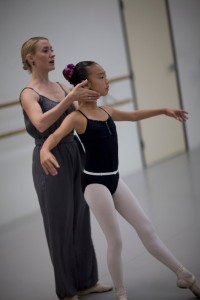Philosophy & Technique
 The Vaganova technique is taught at all levels of the school. Through this classic Russian training, DKCBA focuses on proper placement and technique in an age-appropriate manner. In addition to emphasizing movement of arms, legs and torso together in perfect harmony, the Vaganova technique instills self-discipline and the ability to focus on “learning and practice” for all dancers.
The Vaganova technique is taught at all levels of the school. Through this classic Russian training, DKCBA focuses on proper placement and technique in an age-appropriate manner. In addition to emphasizing movement of arms, legs and torso together in perfect harmony, the Vaganova technique instills self-discipline and the ability to focus on “learning and practice” for all dancers.
DKCBA also offers classes in Character, Pas de Deux and Repertoire and believes it is important to expose students to a variety of dance vocabularies in order to prepare them for maximum opportunities for a professional dance career. Ballet training is supplemented with jazz, lyrical, contemporary and master classes in all genres.
DKCBA students are evaluated on artistry, physicality, maturity and technical ability for acceptance into the school. Placement is determined by the Artistic Directors, and new students must schedule an audition for placement in a particular level or division.
The Vaganova method of classical ballet encourages dancing with the entire body. Dancers trained by the Vaganova method have high jumps and powerful turns, aided by the use of the arms. Many movements of the Vaganova technique require dancers to remain in the air for as long as possible to give them an illusion of floating through the air, which requires great flexibility and extension.
The Vaganova technique encourages dancers to move their arms, legs and torso together in perfect harmony. A strong torso is a necessity for the Vaganova method, as the torso forms the foundation of all movements. The Vaganova method is evident in the technique of Mikhail Baryshnikov, one of the greatest ballet dancers of the 20th century. Baryshnikov is well-known for his extremely high, practically effortless leaps into the air.
